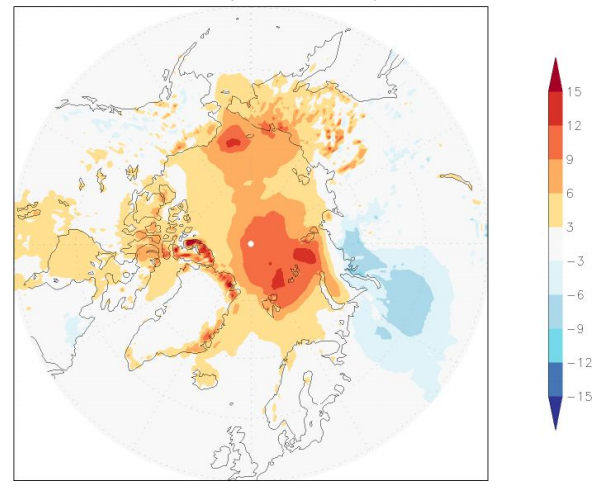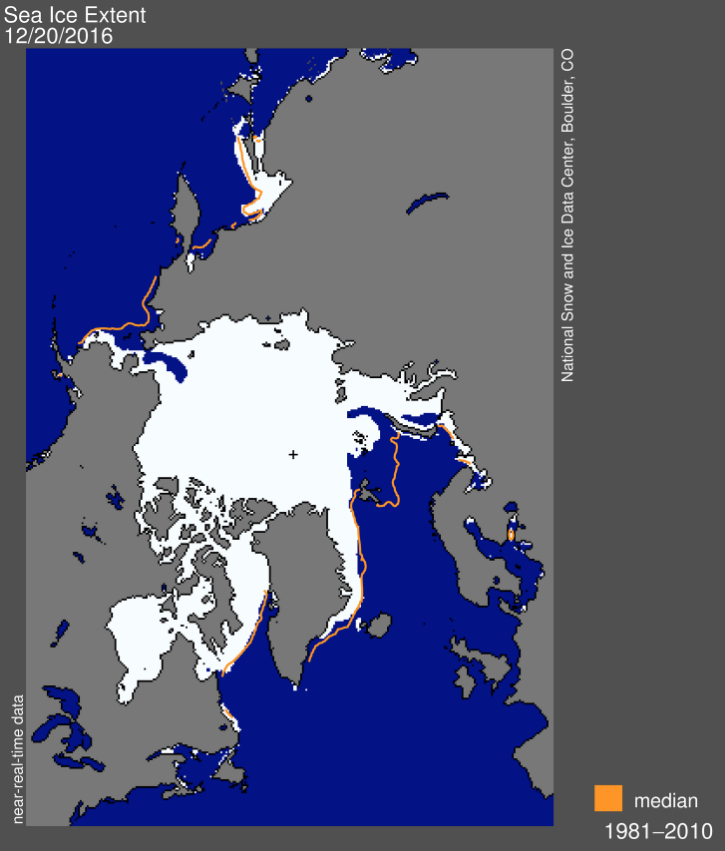
Record-breaking Arctic warmth ‘extremely unlikely’ without climate change
Roz Pidcock
12.21.16Roz Pidcock
21.12.2016 | 3:28pmExceptionally high temperatures across the Arctic this winter are unprecedented in the modern record, and extremely unlikely to occur were it not for the influence of greenhouse gases, according to new research.
A “heatwave” in mid-November caused some parts of the Arctic to be 15C warmer than usual, with average temperatures for November and December across the Arctic as a whole a full 5C above the long term average, according to the quickfire analysis of this year’s unusual winter.
Such an extremely warm winter in Earth’s northern extremity is still a rare event but climate change has “made the event more likely by orders of magnitude”, the authors tell Carbon Brief.
If climate change continues unchecked, we could see similarly high temperatures in the Arctic every other year by the second half of this century, today’s analysis suggests.

November-December temperature anomalies showing some Arctic regions up to 10C warmer than usual for this time of year. Source: World Weather Attribution.
The work, carried out by the World Weather Attribution (WWA) project, is the latest in what are known as “single event attribution” studies. Other recent studies by the same group found that climate change made torrential rains unleashed on south Louisiana in August twice as likely.
‘Unprecedented’ warmth
The Arctic is the fastest warming place on Earth. Temperatures are rising 2.5 times faster than the Earth as a whole, the analysis explains. Warming is most notable in winter, with satellite estimates of November-December temperatures at the North Pole showing a clear upward trend since 1990.
Temperature measurements taken at ground level further south in the Arctic stretch back much further, to around 1900. At 5C above the 1951-1980 average, Arctic temperatures in November-December 2016 are “unprecedented” in the modern record, say the authors of today’s research.

Nov-Dec temperature anomalies relative to 1951–1980 in the Arctic averaged over 70–80N. Green line is the 10-year running average. Source: World Weather Attribution.
The high temperatures have had serious implications for the freezing up of sea ice that usually happens at this time of year. The area of sea ice covering the Arctic ocean even stopped growing and started shrinking in the Barents Sea for a brief period in November. You can read more here about how the last few months have capped off an exceptional year for the Arctic.
Human influence
Did human-caused climate change alter the chances of record high temperatures in the Arctic this winter? To answer this question, the scientists compared actual measurements for the Arctic in November and December with two different “versions” of 13 different climate models.
One combined scientists’ best understanding of how natural variability and greenhouse gases drive temperatures changes in the Arctic. The other replicated a hypothetical world where natural variability exists but there is no long-term warming coming from greenhouse gases.
The results suggest that an event like 2016, or a hotter one, would have been “extremely unlikely” without human-induced climate change. In a world with just natural influences, such an event wouldn’t have happened at all, the authors say.
The scientists got a very similar result when they repeated their analysis with a different set of models (those used in the Weather@Home project), strengthening confidence in their conclusion that the record high temperatures were highly unlikely in the absence of climate change.
Dr Geert Jan van Oldenborgh from The Royal Netherlands Meteorological Institute (KNMI), one of the team of scientists who carried out the work, tells Carbon Brief why using multiple methods is important, particularly somewhere as remote as the Arctic. He says:
“Observations in that part of the world are rare… by combining independent methodologies we are able to assess what we can say independent of a specific uncertain methodology.”

Arctic sea ice extent for 20 Dec 2016. Orange line is the 1981-2010 average. Source: NSIDC.
While previous years have also seen large spikes in November-December temperatures, these peaks are occurring on top of a upward trend, says Prof Jennifer Francis, an expert in Arctic climate change at Rutgers University. She tells Carbon Brief:
“The far north has indeed been behaving bizarrely in Nov/Dec 2016, setting many new records for temperature, sea ice extent, atmospheric water vapour content, and Arctic amplification (the difference in temperature between the Arctic and northern mid-latitudes)”
The “uptick” in Arctic amplification is most worrisome, says Francis, because of the possible implications for extreme weather much further south. She tells Carbon Brief:
“Recent studies by several groups suggest that a very warm Arctic in late fall – particularly in the region north of Scandinavia as we’ve seen this year – tends to favour cold spells in Eurasia…This year’s records portend a very “interesting” winter for the northern hemisphere.”
‘Commonplace’
The scientists behind today’s analysis used the same 13 climate models to investigate how often we might see a repeat of such high Arctic winter temperatures in future as warming continues.
They found that by about 2050, extreme heat like the Arctic experienced in 2016 will be “commonplace” if emissions continue unchecked, with around half of Arctic winters as hot or hotter. Or as Dr Friederike Otto, an expert in modelling extreme events at the University of Oxford and part of the research team, tells Carbon Brief:
“If nothing is done to decrease greenhouse gas emissions a rare event like this could be expected to happen every other year by the second half of this century.”
Even if global temperature rise was halted at 2C above pre-industrial levels – the internationally agreed target – temperatures as high as those in 2016 would not be considered unusual, say the scientists. This should be cause for great concern, Otto adds:
“The Arctic is warming faster than any other region on Earth and is changing beyond recognition as open water replaces sea ice and permafrost is thawing. It is one of the large ecosystems where we already see a large impact of anthropogenic climate change.”

Arctic sea ice extent for 2016, up to and including 20 December. Source: NSIDC.
Though the results from attribution studies such as this one tend to be released before they’ve been through the traditional process of peer-review, the methods underpinning them are peer-reviewed and well established, van Oldenborgh tells Carbon Brief. And the methods scientists use to assessing the human contribution to extreme events are advancing all the time, he adds:
“As a region with not many observations and unique modelling challenges, it is a different challenge than e.g. in [the] Louisiana [floods]…We are constantly learning.”
With changes in the Arctic so pronounced this year, it’s important that attribution efforts are channelled into these high latitude regions. As Dr Mark Serreze from the US National Snow and Ice Data Set (NSIDC), who wasn’t involved in the new analysis, explains to Carbon Brief:
“I am always cautious about reading too much into individual extreme events. However, what has happened in the Arctic last winter and this autumn has certainly caught my attention.”
-
Record-breaking Arctic temperatures this winter were extremely unlikely to occur without climate change - study

